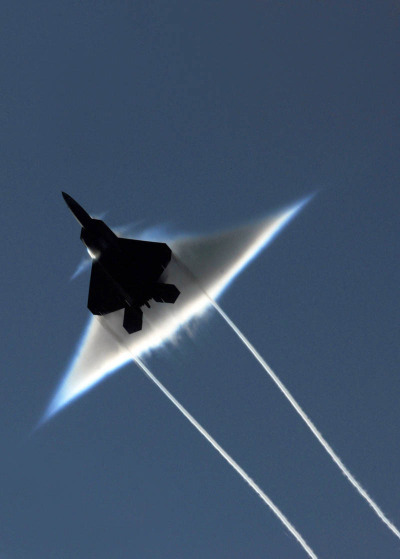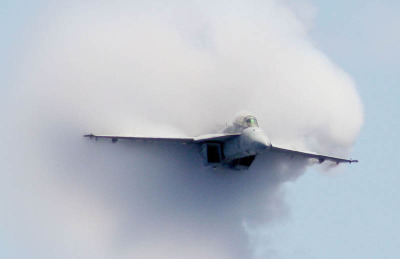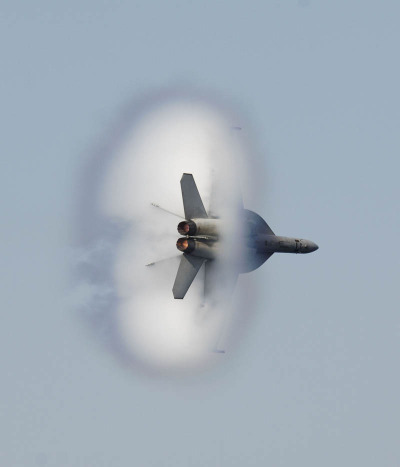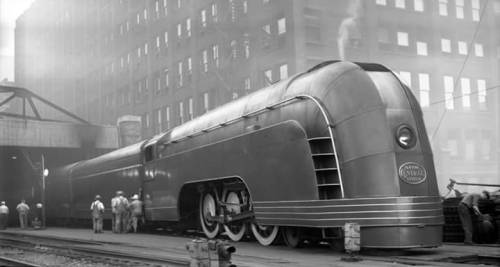Technical Drawings Of An F4U Corsair







Technical drawings of an F4U Corsair






More Posts from Engineeringtrivia-blog and Others






The Vapor Cone.
A vapor cone, also known as shock collar or shock egg, is a visible cloud of condensed water which can sometimes form around an object. A vapor cone is typically observed as an aircraft, or object, flying at Transonic speeds. ( slightly slower than the speed of sound)
The Pressure - Temperature dependence.
As the aircraft approaches the speed of sound, the air pressure around the object drops, and thereby the air temperature drops. If the temperature drops below the dew point, water in the atmosphere condenses to form a cloud in the shape of the shockwave.
Red Bull Stratos and the Vapor Cone.
Remember that epic jump where Felix Baumgartner, as a part of the Red Bull Stratos project broke the sound barrier ( reached Mach 1.25 ) during his descent? But why weren’t vapor cones seen around Felix’s body? Or were they?

Vapor cones are formed only near the ground, where plenty of wet air persists. But when Felix broke the sound barrier, there was no wet air that surrounded him that would enable the formation of Vapor cones.
Have a Good day!
PC: twistedsifter

The United Engineering Center, 345 E. 47th Street, New York City, was headquarters to the major engineering United States engineering societies (ASCE, AIME, ASME, IEEE, AIChE and the UEF) from 1960 to 1997. In 1997, the building was sold to Donald Trump and demolished in 1998 to make room for the Trump World Tower, a 72 floor residential tower.

Dawn O'Mara sitting on the edge of the front cockpit of a de Havilland DH82 Tiger Moth biplane, circa 1953.









Gravitational Waves Win 2017 Nobel Prize In Physics, The Ultimate Fusion Of Theory And Experiment
“The 2017 Nobel Prize in Physics may have gone to three individuals who made an outstanding contribution to the scientific enterprise, but it’s a story about so much more than that. It’s about all the men and women over more than 100 years who’ve contributed, theoretically and experimentally and observationally, to our understanding of the precise workings of the Universe. Science is much more than a method; it’s the accumulated knowledge of the entire human enterprise, gathered and synthesized together for the betterment of everyone. While the most prestigious award has now gone to gravitational waves, the science of this phenomenon is only in its earliest stages. The best is yet to come.”
It’s official at long last: the 2017 Nobel Prize in Physics has been awarded to three individuals most responsible for the development and eventual direct detection of gravitational waves. Congratulations to Rainer Weiss, Kip Thorne, and Barry Barish, whose respective contributions to the experimental setup of gravitational wave detectors, theoretical predictions about which astrophysical events produce which signals, and the design-and-building of the modern LIGO interferometers helped make it all possible. The story of directly detecting gravitational waves is so much more, however, than the story of just these three individuals, or even than the story of their collaborators. Instead, it’s the ultimate culmination of a century of theoretical, experimental, and instrumentational work, dating back to Einstein himself. It’s a story that includes physics titans Howard Robertson, Richard Feynman, and Joseph Weber. It includes Russell Hulse and Joseph Taylor, who won a Nobel decades earlier for the indirect detection of gravitational waves. And it’s the story of over 1,000 men and women who contributed to LIGO and VIRGO, bringing us into the era of gravitational wave astronomy.
The 2017 Nobel Prize in Physics may only go to three individuals, but it’s the ultimate fusion of theory and experiment. And yes, the best is yet to come!

The simple physics behind a Fidget Spinner
When you want something to spin for a really long time you need to make sure that the friction does not slow it down.

And we can do this by adopting ball bearings. This is so because friction offered due to rolling is much smaller than due to sliding.

And many Fidget spinners indeed use ceramic ball bearings to keep them spinning for a long time. **
Mass Distribution
The next most crucial component is the Angular Momentum. Angular momentum is equal to the product of rotational velocity and the moment of inertia.

And by distributing more mass towards the edge, the fidget spinner gains high moment of inertia keeping it spinning longer.
That’s why the spinners have that weird peculiar shape.
But, Why do they feel alive ?

The angular momentum of a fidget spinner happens to point outwards from the spinner’s center.
And so to change the direction of the momentum — rotating the spinner with your fingers — you must apply a force. You push on the spinner, and the spinner pushes back on you.
That’s why a fidget spinner feels like it fights you, like it’s alive.
- Nerdist
A very fascinating toy nevertheless!
** Spin Test : Ceramic Vs Steel ball bearings
*** Fidget spinner trick shots


Hydro Robotics! 1/3


F1 is more than just racing, it is an engineering battle. In this gif you can see the absolute control of wing tip vortices generated from the front wing. This is just an example to show the extreme aerodynamics that these vehicles are engineered for.
Have a great day!
* What are wing tip vortices ?
** Smoke angels and wing tip vortices
Take a Virtual Tour of NASA
Welcome to NASA! Today, we’re taking you behind-the-scenes for a virtual tour looking at our cutting-edge work and humanity’s destiny in deep space!

Starting at 1:30 p.m., we will host a series of Facebook Live events from each of our 10 field centers across the country. Take a look at where we’ll be taking you…
Glenn Research Center 1:30 p.m. EDT

Our Glenn Research Center in Cleveland, OH will host a tour of its Electric Propulsion Lab. This lab is where we test solar propulsion technologies that are critical to powering spacecraft for our deep-space missions. The Electric Propulsion Laboratory houses two huge vacuum chambers that simulate the space environment.
Marshall Space Flight Center 1:50 p.m. EDT

Our Marshall Space Flight Center in Huntsville, AL will host a tour from a Marshall test stand where structural loads testing is performed on parts of our Space Launch System rocket. Once built, this will be the world’s most powerful rocket and will launch humans farther into space than ever before.
Stennis Space Center 2:10 p.m. EDT

Our Stennis Space Center in Bay St. Louis, MS will take viewers on a tour of their test stands to learn about rocket engine testing from their Test Control Center.
Armstrong Flight Research Center 2:30 p.m. EDT

Our Armstrong Flight Research Center in Edwards, CA will host a tour from their aircraft hangar and Simulator Lab where viewers can learn about our X-Planes program. What’s an X-Plane? They are a variety of flight demonstration vehicles that are used to test advanced technologies and revolutionary designs.
Johnson Space Center 2:50 p.m. EDT

Our Johnson Space Center in Houston, TX will take viewers on a virtual exploration trip through the mockups of the International Space Station and inside our deep-space exploration vehicle, the Orion spacecraft!
Ames Research Center 3:10 p.m. EDT

Our Ames Research Center in California’s Silicon Valley will bring viewers into its Arc Jet Facility, a plasma wind tunnel used to simulate the extreme heat of spacecraft atmospheric entry.
Kennedy Space Center 3:30 p.m. EDT

Our Kennedy Space Center in Florida will bring viewers inside the Vehicle Assembly Building to learn about how we’re preparing for the first launch of America’s next big rocket, the Space Launch System (SLS) rocket.
Langley Research Center 3:50 p.m. EDT

Our Langley Research Center in Hampton, Virginia will bring viewers inside its 14-by-22-foot wind tunnel, where aerodynamic projects are tested.
Goddard Space Flight Center 4:10 p.m. EDT

Our Goddard Space Flight Center in Greenbelt, MD will discuss the upcoming United States total solar eclipse and host its tour from the Space Weather Lab, a large multi-screen room where data from the sun is analyzed and studied.
Jet Propulsion Laboratory 4:30 p.m. EDT

Our Jet Propulsion Laboratory in Pasadena, CA will bring viewers to the Spacecraft Assembly Facility to learn about robotic exploration of the solar system.
So, make sure to join us for all or part of our virtual tour today, starting at 1:30 p.m. EDT! Discover more about the work we’re doing at NASA and be sure to ask your questions in the comment section of each Facebook Live event!
Additional details and viewing information available HERE.
Make sure to follow us on Tumblr for your regular dose of space: http://nasa.tumblr.com

One of New York Central’s “Mercury” engines in Chicago, 1936.
You cannot drown in Quick Sand!
No! Seriously. You cannot.
But I saw it in the movies or in the cartoon (C’mon bro, cartoon?). The gimmick that movies bring in, phew! They sometime just butcher the science out of things for entertainment.
What is Quick Sand?

Remember Oobleck, the non- newtonian fluid that hardens on the application of force?
Well, Quick Sand ( also a non-newtonian fluid ) liqueifies on the application of force.

Why you can’t sink?
Quicksand itself is harmless: a human or animal is unlikely to sink entirely into quicksand at all due to the higher density of the fluid ( It has twice the density of human )

It’s the same reason why a ship although made up of steel, yet stays afloat at sea. “The heavier the fluid, the better things float.”
But for the ship to sink it has to push aside some water, which has nowhere to go but up. So it’s a question: does the ship ‘want’ to sink more than the water ‘wants’ not to rise?
It turns out that just depends on whether the ship weighs more or less than the amount of water that would fill the same space. Real ships have lots of air inside, so they weigh less than the same volume of water, so they float.
Getting out of it albeit, is a real pain.
That being said, it is no joke that people have lost their lives in Quicksand. But the rationale for their death is often misattributed.

It’s not the quicksand that will kill you, but the sunlight, dehydration, carnivores, omnivores, hypothermia or tides that will.

It takes a feat of strength to get out of one though.
A study published in Nature found that the force needed to pull your foot out of quicksand at a speed of one centimentre per second would be equivalent to lifting a medium-sized car (in air).
So,How do you get out of it?
Well, who would be a better person to explain it than Bear Grylls himself.

Getting out of a Quicksand with Bear Grylls.
-
 slowlysurelydefinitely liked this · 4 years ago
slowlysurelydefinitely liked this · 4 years ago -
 n30999 liked this · 4 years ago
n30999 liked this · 4 years ago -
 jpmuzz reblogged this · 4 years ago
jpmuzz reblogged this · 4 years ago -
 jpmuzz liked this · 4 years ago
jpmuzz liked this · 4 years ago -
 drearmoon reblogged this · 4 years ago
drearmoon reblogged this · 4 years ago -
 fucking-tried liked this · 5 years ago
fucking-tried liked this · 5 years ago -
 itsoneloafofbreadareyoukiddingme liked this · 5 years ago
itsoneloafofbreadareyoukiddingme liked this · 5 years ago -
 brick5-360inc liked this · 5 years ago
brick5-360inc liked this · 5 years ago -
 olds680 reblogged this · 5 years ago
olds680 reblogged this · 5 years ago -
 skidawg1 liked this · 5 years ago
skidawg1 liked this · 5 years ago -
 uliven liked this · 5 years ago
uliven liked this · 5 years ago -
 bigwave18 liked this · 5 years ago
bigwave18 liked this · 5 years ago -
 cantoleo33 liked this · 5 years ago
cantoleo33 liked this · 5 years ago -
 ace-7 reblogged this · 5 years ago
ace-7 reblogged this · 5 years ago -
 ace-7 liked this · 5 years ago
ace-7 liked this · 5 years ago -
 malkorsai reblogged this · 5 years ago
malkorsai reblogged this · 5 years ago -
 malkorsai liked this · 5 years ago
malkorsai liked this · 5 years ago -
 usafphantom2 reblogged this · 5 years ago
usafphantom2 reblogged this · 5 years ago -
 usafphantom2 liked this · 5 years ago
usafphantom2 liked this · 5 years ago -
 zoomingcorsaircat liked this · 5 years ago
zoomingcorsaircat liked this · 5 years ago -
 planeinsane liked this · 5 years ago
planeinsane liked this · 5 years ago -
 homesicktexan liked this · 5 years ago
homesicktexan liked this · 5 years ago -
 wngnyc liked this · 6 years ago
wngnyc liked this · 6 years ago -
 hawkerhind liked this · 6 years ago
hawkerhind liked this · 6 years ago -
 bumblr-1 liked this · 6 years ago
bumblr-1 liked this · 6 years ago -
 frozenhunter369 liked this · 6 years ago
frozenhunter369 liked this · 6 years ago -
 jewfro14 reblogged this · 6 years ago
jewfro14 reblogged this · 6 years ago -
 east-tennessee-gentleman liked this · 6 years ago
east-tennessee-gentleman liked this · 6 years ago -
 db605 liked this · 6 years ago
db605 liked this · 6 years ago -
 damie-erica-blog liked this · 6 years ago
damie-erica-blog liked this · 6 years ago -
 longschacht reblogged this · 6 years ago
longschacht reblogged this · 6 years ago -
 longschacht liked this · 6 years ago
longschacht liked this · 6 years ago -
 legio-63 reblogged this · 6 years ago
legio-63 reblogged this · 6 years ago -
 walter4221 liked this · 6 years ago
walter4221 liked this · 6 years ago